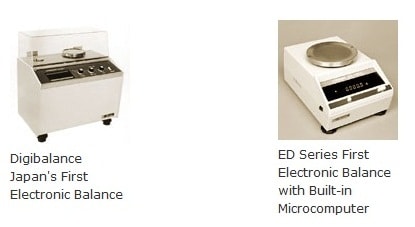"Electronic Balance," Which Greatly Reshaped the History of Balances
- Balance History
- The Beginning of Shimadzu Balances
- Birth of the Revolutionary New Type of Balance "Direct-Reading Balance"
- "Electronic Balance," Which Greatly Reshaped the History of Balances
- UniBloc Technology
The revolutionary type of balance — direct-reading balance — shortened conventional measurement times to about 1/3. About 20 years after it first appeared, Shimadzu successfully developed and commercialized the electronic balance in 1971, a development that was to greatly reshape the history of balances.

This marked a turnabout in conventional thinking behind weighing which up till then had involved a series of mechanical, troublesome operations. This was the very beginning of what is taken for granted today: weighing is simply turning the balance on and placing the sample on the pan.
By the way, electronic balances around that time were as high as about 30 cm. In the early days they still had no microcomputer chip as well. All signals were extracted from a mechanical unit, and digital display was performed solely by electrical circuits made up of transistors and other components. Then, in 1978, Shimadzu started sales of the ED series of electronic balances, the first to incorporate a microcomputer chip, which improved measurement speed even further. From then on, Shimadzu has continued to successively introduce more compact and lower-priced models into the market.
Even now, naturally, higher measurement accuracy and shorter measurement speeds are the most important themes for balances. Recently, however, how handy and easy-to-operate balances can be made is also an important factor. Various convenient features and measures are incorporated into recent balances, including a self calibration function, built-in clock function and the Windows®Direct function for enabling a simple PC connection. Besides enhancing performance, Shimadzu will keep its focus on the needs of the future and will steadily continue to develop balances that will aid and help everyone.
>>Click here for details on current models


